by Briscoe White | Feb 24, 2011 | Basics, Containers, Gardening, Growing, Herbs, Indoor Gardening, Inspiration, Miscellaneous, Recipes |
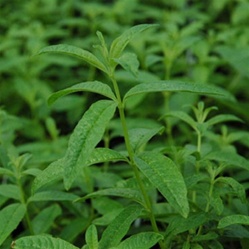
I know I say this with many herbs, but Lemon Verbena has to be one of my absolute favorites. It is easy to grow and maintain, loves living in a pot on the windowsill, and smells delightful! Lemon Verbena has a wonderful lemon flavor with no bitterness– nature’s lemon candy. Try adding a few leaves to your next cup of tea, or steep a few leaves in milk to be used in pudding or ice cream. You could even see if you can find some Lemon Verbena scented wax melts and use deluxe aroma burners to really fill your home with the scent.
Lemon Verbena likes warm, sunny conditions and well-drained soil. If kept warm inside all year, lemon verbena is an evergreen perennial; if exposed to frost, it is deciduous. Do not over-water, and prune in the fall for a bushier plant in the spring.
As previously stated, Lemon Verbena’s lovely medium-green leaves give off a light lemony scent. Before guests arrive I make sure to shake and brush the leaves around a bit, to stimulate the essential oils and really release the natural aroma of my indoor verbenas. Guests love it, especially on cold winter nights when we’re dreaming of summer lemonade and sunshine.. And might I add how much healthier it is to have fresh, all-natural, sweet-smelling herbs and flowers in your house, rather than scented candles and air fresheners? Scented candles are one of the most popular house-hold carcinogens. Plants, on the other hand, detoxify your home!
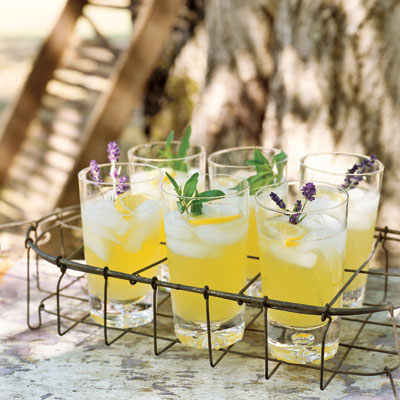
One common problem associated with Lemon Verbena is spider mites. They love the underside of the leaves. Keep an eye out for these little buggers, and if you do have a problem pick up a mild non-toxic insecticide at your favorite store. You can also companion plant herbs that are natural insecticides, like Rue, Pyrethrum and Tansy nearby to help discourage unwanted pests!
by Briscoe White | Feb 22, 2011 | Basics, Gardening, Growing, Herbs, Inspiration, Miscellaneous |
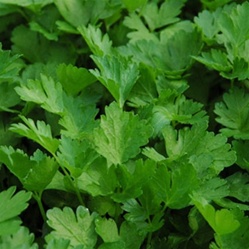
Italian Flat Leaf Parsley
Happy Parsley Day! On February 22nd, we take time to honor a much loved culinary and medicinal herb that packs a punch of flavor! An herb, a spice AND a vegetable all in one plant, this dynamic herb is a key component in many cuisines like Middle Eastern and Spanish, but is most distinctly known in Italian dishes. Parsley symbolizes love, protection and purification and throughout history has been a sign of honor and class. Ancient Greeks used Parsley to honor champions of sporting events, and it was also used in wreaths and sprinkled on the dead. The word “Parsley” is derived from the Greek word meaning “rocks or stones”, which reflects the terrain Parsley is native to. They believed that Parsley grew in the spot where the mythological hero Archemorus was slain.
The two main varieties, Italian Flat Leaf and Curly, are adored for different reasons. While some believe the Flat Leaf is easier to grow, it is the quintessential Parsley for cooking, as it has a more flavorful taste. The soft, crinkled look of the Curly Parsley makes it a great garnish and it is used to enhance many gourmet dishes with its beauty. Also a necessary component to the favorable herbal combination, Bouquet Garni, Parsley tastes terrific with hearty dishes like potatoes, stews, lamb, lasagna or rice.
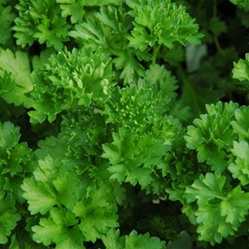
Curly Parsley
Medicinally, Parsley has a long history of being associated with women’s health. An emmenagouge, it was often used to start the menstrual cycle, but should not be consumed in great quantity by pregnant women. Parsley also contains elements that help the body absorb Manganese much more efficiently, an important mineral for strengthening bones. When paired with dishes that contain high zinc or copper-rich foods, it helps retain these bone-improving vitamins and minerals much more thoroughly. When applied directly to insect bites, it is also said to soothe the itching or stinging sensation!
A great companion plant, Parsley attracts insects, diverting their attention from other garden growers. Plant Parsley near your tomatoes to draw the attention of pesky tomato hornworms, moths and flies away from your veggies. Parsley thrives in full sun, with moist, well-drained soil, but because of its tough seed coat, it can often be hard to germinate from seed. If germination actually does occur, it should only take four to six weeks to see sprouts peeking through the soil. Superstition says that the reason that Parsley takes so long to germinate is because it has to travel to Hell and back seven times before sprouting. Though we aren’t sure where this delightful herb got such a bad rap, we assure you, it’s been growing safe and sound in our greenhouse!
by Briscoe White | Feb 7, 2011 | Basics, Gardening, Growing, Herbs, Pests and Problems |
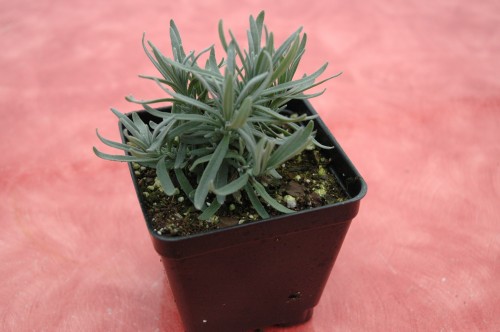
Healthy Lavender
Keeping potted lavender inside for winter can be tricky. They are so touchy about wet feet, they can turn from beautiful to pitiful in a few days. Overcast days with little sun are the perfect breeding ground for all the fungus that prey on lavender plants. Like potting succulents, sand should be added to the potting soil to insure quick drainage.
One sign of trouble is algae growing on the soil surface. This is an indication the soil is too wet for too long. When weather conditions are favorable, fungus will quickly colonize a water logged lavender. To save plants already infected, trim all dead leaves and stems. Clean all debris from the soil surface. Dry the soil quickly, even if you must remove the plant from the pot.
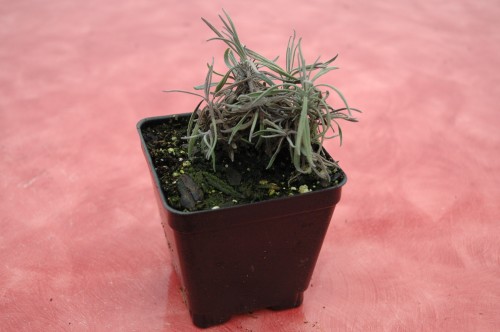
Fungally infected Lavender
There are many fungicides available, some are biological, others chemical. This natural fungicide is safe for kids and pets so if you’re conscious about little fingers or paws playing in the garden, a natural fungicide is often a better choice than a chemical one. In our greenhouse, we treat lavender every week by first spraying a Hydrogen Peroxide disinfectant, then a biological fungicide. Applying chemical fungicides takes less time because it has a residual effect for a week or more, but because we grow mostly herb plants that will be cut and used for culinary purposes, they must be clean and healthy to eat. Though the biological type does not last as long and must be applied more regularly, it’s worth the extra time and effort to ensure that our plants are healthy and treated in an all-natural way.
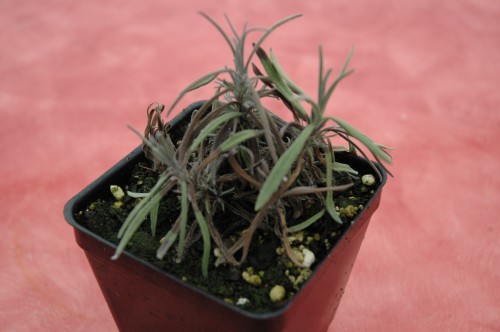
Lavender killed by fungal infection
We prefer to use PlantShield HC Biological Fungicide, which uses an active natural microbe to prevent disease from growing on the root structures and foliage of our plants. We drench the actual soil, rather than the leaves themselves, which allows this natural microbe to saturate the soil and protect the plants from mildew, fungi and other root pathogens. This is just one key step in our promise to ensure healthy, all natural herbs and flowers for our customers. Because of all of the careful nurturing that we employ at The Growers Exchange, we know our plants like the backs of our hands. Staying constantly familiar with our plants allows us to keep a close eye on quality control, and our attention to detail is something we pride ourselves on. Because of this process, we don’t let anything leave our greenhouse that we wouldn’t want to plant in our own garden, so you can be sure that when you order from us, you’re getting only the very best!
by Briscoe White | Feb 3, 2011 | Basics, Containers, Gardening, Growing, Herbs, Indoor Gardening, Seeds, Urban Gardening |
Nasturtiums are typically started from seed– but why do the sowing yourself, when we are happy to sow them for you? While most of the country is experiencing another record-setting snowy winter, your nasturtiums are in good hands here on the farm, safe in our warm and well-tended greenhouse. While most people are ordering seeds that ship immediately, we’re nurturing and hand tending our plants with care until it is warm enough to ship them via mail couriers like Fedex, this spring. This way, you get healthy, happy plants that arrive on your doorstep and are ready to plant or pot, instead of seeds that have battled the rigors of the icy weather AND the postal system. Our nasturtiums are a great example. Below, see us starting these little guys on their life journey.
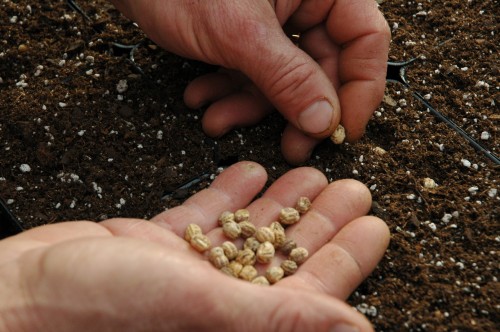
Sowing Nasturtium seeds
When spring arrives at last and you receive your Nasturtiums, plant them in well-drained soil and full sun. They are easy to grow, and do not require a lot of maintenance. In fact, they do better with a little neglect. They like weekly waterings, or whenever soil is dry to the touch.
Nasturtium leaves have an interesting watercress flavor to them, and are a wonderful addition to salads and cheese sandwiches. Use them to spice up cream cheeses, dips, or egg dishes. Colorful nasturtium flowers are not only beautiful, but are also edible. Many health food stores carry these edible flowers– but at a high price! Take advantage of your nasturtiums by picking their flowers soon after they open up. The flowers can be served whole as a gorgeous decoration to cakes, or petals can be sprinkled on salads.
If you would rather keep your blooms on your plant, be sure to remember to pick off dead blooms. This will allow your nasturtium to bloom continuously. If you don’t dead-head them, they will start to go to seed, as our social director Caroline recently discovered! You can read about her experience in our previous blog. These seeds can also be pickled and used as you would use capers.
by Briscoe White | Dec 22, 2010 | Basics, Containers, Flowers, Gardening, Herbs, Indoor Gardening, Miscellaneous |
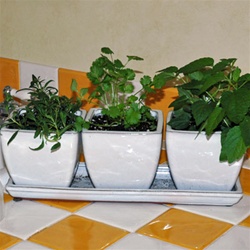
With winter here and in full force already (whether we like it or not), I’ve had to bring in a number of our outdoor plants. My first concern was to find space for all of the various sized pots and to make sure no one was going to trip over them. Once I had my living clutter settled in for the season, I began thinking about how to keep them healthy and happy throughout these long cold months, especially when we have everything from cacti to hardy herbs like Rosemary. Depending on what type of plants have moved into your home for the holidays, here are some general rules of thumb and just plain good advice for keeping them alive and well.
Lighting
We don’t think much about the amount of light outside as it changes from season to season, when we’re indoors and warm with electric lights, but this is a major factor for your plants. Especially with this time of year being the shortest amount of daylight we’ll see, you need to make sure your plants are getting the amount they need. Though probably dormant for the season, your flowering plants tend to like more light than evergreens, cacti and other foliage hardy plants. Whether you unsash your curtains, open the blinds or add additional artificial light, your plants will need a little UV boost through the winter. Even getting your hands on the best led grow lights will offer your plants with the right amount of sunlight that can help them to flourish in their surroundings. Make sure to turn them occasionally to allow all sides and leaves to get plenty of light. This will also help them from growing at a crooked angle, as most tend to grow towards a light source.
Water
If you’re feeling dried out from running your heat on high, chances are that your plants may be, too. Make sure to water them appropriately. Excluding cacti and other succulents, an easy way to tell if your plant needs water is to stick your finger partially into the dirt to test it. If it’s bone dry, don’t drown it. Water moderately and monitor its progress. If you find that your plants are needing water at alarming rates, check to see where you have them placed. On top of a radiator or next to your fireplace may be too hot for their liking.
Temperature
So, you’ve moved your little green friends indoors and you figure that should keep them safe from the temperatures, right? Think again. Some plants can be highly sensitive to heat and cold so make sure you aren’t placing your Basil plant near a cold, drafty vent or your Lemongrass right beside your wood furnace. Depending on their particular needs, temperature can even speed and slow the growth process for your plants, just like an artificial changing of the seasons. For example, with Amaryllises, because they are flowering bulbs, temperature plays a huge part in their growth cycle. We brought some in from the greenhouse for the holidays and the ones placed near our radiator bloomed in a week! I guess we tricked them into thinking it was Spring!
Cleaning and Prevention
Another great thing about having your plants close at hand when it’s too cold to go outside, is that you can’t help but to notice them. The winter months are a great time to get to know your plants’ personalities and to give them a good cleaning. Dust and microscopic debris build up on the plant’s leaves which can block sunlight and the plant’s pores. Try cleaning the tops and bottoms of your plant’s leaves with a damp cloth to remove any unwanted buildup that may be hindering your plant from being its healthiest. While you’re at it, take a close look for insects and disease. For a longer lasting plant, it’s best to nip an infestation or blight in the bud. In most cases, warm water and a mild soap will do the trick to remove many common pests. For a deeper rooted problem, try an all natural pesticide or fungicide, which can be bought at your local hardware store.
Positioning
Plants prefer a routine and moving them into your home can be quite an adjustment. To alleviate further disruption to their transition indoors, try to find permanent spots for them when you bring them in. If you can place them in areas where they won’t be disturbed by the hustle and bustle of the holidays, pets, kids or just because they’re in the way, they’ll greatly appreciate it. Moving potted plants too often can really disrupt and unsettle their soil and root structure. Leaving them to settle in and stay sedentary will cause the least amount of stress on them, as leaves, stems, flowers and branches can break, become weak or tear during the moving process. This will also allow the roots to stay strongly grounded, as soil won’t be jostled about, loosening the plant’s hold.
Potting
Making sure your plants are in the best pot or container is also crucial to its health. Think about it. When you start to outgrow your shoes, the constriction and tightness is uncomfortable, right? Well, many plants need to be moved to larger containers as they get bigger to give them more adequate space to stretch and grow bigger. The winter is a great time for this as the cool temperatures make the process less stressful on your plants. Give your plants plenty of room to grow and you’ll get to enjoy larger and longer lasting results.
Once the stress of the holidays has wound down, indoor gardening can be a terrific therapeutic hobby…or, during the holidays if you need an escape from the madness! Gardening, in general, can actually make for a very fulfilling past time as it can keep you productive, environmentally-minded, creative and, by growing your own produce, can actually save you money. For other hobby ideas, be sure to visit this website – https://tlhobbyideas.com. Gardening year round allows you to enjoy the fruits of your hard work constantly and the calming presence of your indoor plants will bring beauty and fresh aroma to these bleak winter days. Many plants can be easily started indoors during the colder months, for transplant in the spring to an outdoor garden. Try growing your favorite culinary herbs indoors this season to spice things up in your stews and other hearty recipes or just to lend a savory fragrance to your home. By growing now, you will be more prepared once spring gets here!
by Briscoe White | Dec 13, 2010 | Basics, Herbs, Life on the Farm |
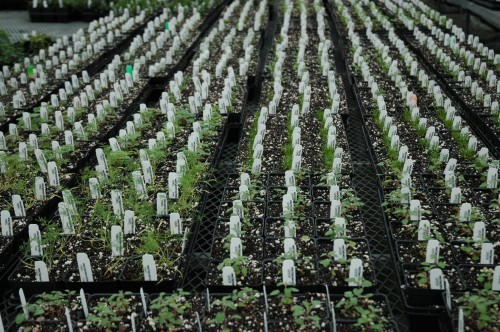
Our seedlings are growing strong!
Though the weather outside is frightful, spring planting can be delightful! Sounds strange, but that is what we are doing here at The Growers Exchange. Seeds were planted several weeks ago and many are now ready to transplant into their final pots. Some plants take a long time to grow from seed, so we start early to insure large well-rooted plants for planting out this coming spring.
Eucalyptus Silver Drop, Feverfew, Comfrey, and others require several months to gain the size and maturity they will need to grow even larger next summer. So, even though it does not feel like spring, we are busy getting ready for when it really does arrive.
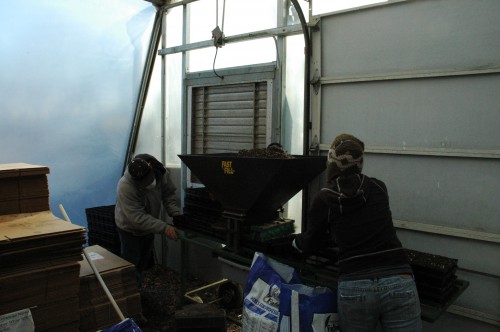
Ino and Annie filling flats!
A good indication of today’s weather is how the greenhouse staff is dressed while filling flats. I hope we don’t need that much clothing much longer!











